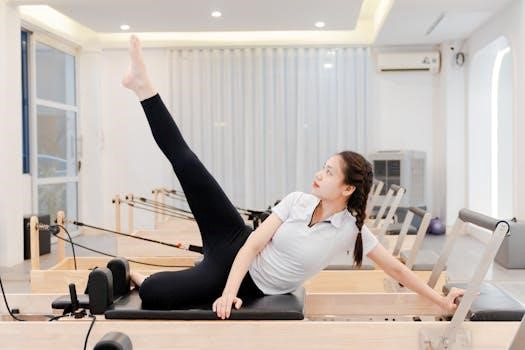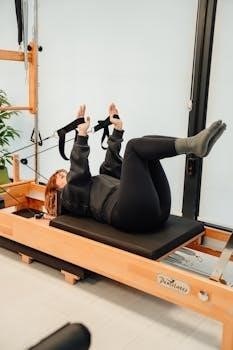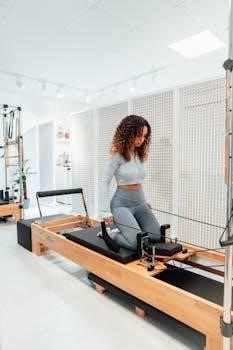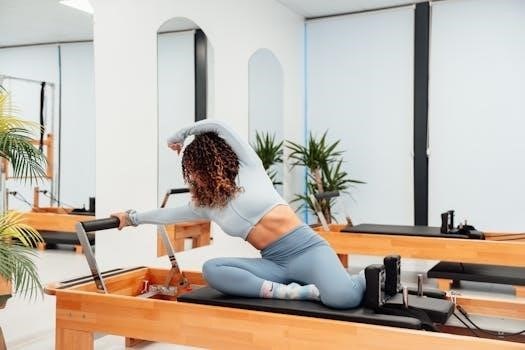Reformer Pilates is a unique exercise style using specialized equipment to enhance muscle engagement and body alignment. It offers a full body workout focusing on core strength, flexibility, and control. The reformer’s resistance levels can be adjusted to suit beginners to advanced practitioners.
Understanding the Pilates Reformer
The Pilates reformer is a sophisticated piece of exercise equipment that uses a system of springs, ropes, and a sliding carriage to provide resistance and support during workouts. Unlike mat Pilates, which relies solely on body weight, the reformer allows for a wide range of exercises that can be modified to suit various fitness levels and abilities. The carriage moves along rails, offering a dynamic surface that challenges stability and control. The springs provide adjustable resistance, enabling exercises to be made easier or more challenging. The reformer enhances muscle engagement and body awareness. It promotes core stability, flexibility, and full-body strength. This equipment is a versatile tool that allows for diverse movements and targets multiple muscle groups simultaneously. The adjustable nature of the reformer means it is equally effective for beginners and advanced practitioners. It provides support and resistance, enabling users to achieve their fitness goals more effectively. It allows for precise movements and a greater range of motion compared to traditional exercises. By understanding these components, one can appreciate the benefits of reformer workouts.

Pilates Reformer Exercises by Level
Pilates reformer exercises are categorized into beginner, intermediate, and advanced levels. This structure allows individuals to progress safely and effectively, building strength, coordination, and confidence at a comfortable pace.
Beginner Pilates Reformer Exercises
Beginner Pilates reformer exercises focus on foundational movements, teaching proper form and alignment. These exercises often utilize lighter resistance, helping to build a strong base before progressing. Footwork is a staple, involving simple pushes with the feet against the footbar, promoting leg and core engagement. The Hundred, a classic Pilates exercise, is adapted on the reformer to enhance core control and breathing. Other beginner exercises include single leg circles, double leg stretches, and modified swan dives. These movements aim to improve stability, flexibility, and body awareness. These exercises are essential for building a strong foundation before moving onto more complex and challenging exercises. They are designed to be safe and effective for those new to reformer Pilates, ensuring a positive and encouraging start to their fitness journey. Proper form and technique are emphasized, to prevent injury.
Intermediate Pilates Reformer Exercises
Intermediate reformer exercises build upon the foundations learned in beginner classes, introducing more complex movements and increased resistance. These exercises challenge stability and require greater coordination, improving overall strength and endurance. The Teaser, a common intermediate exercise, demands core strength and control as you lift the upper body and legs off the carriage. Side-lying exercises, like side kicks and side planks, target the obliques and hips. Frog and elephant exercises engage the core and challenge pelvic stability. Intermediate routines often incorporate more repetitions and variations of basic movements. They demand a deeper understanding of body awareness and control. These exercises prepare the body for more advanced moves, while continuing to improve flexibility and posture. Proper transitions between exercises are also a focus, enhancing the flow of the workout. Intermediate exercises are vital for continuous progression on the reformer.
Advanced Pilates Reformer Exercises
Advanced reformer exercises demand significant strength, endurance, and coordination. These movements involve complex patterns, requiring full body engagement and precision. Exercises like the Long Spine Massage and the Control Balance series challenge both strength and flexibility, pushing the practitioner’s limits; Advanced routines often incorporate multiple planes of motion and require advanced core stabilization. Inversions and exercises that involve balancing on the reformer are also common at this level. Transitions become more intricate, demanding a high level of control and body awareness. Practitioners must have a deep understanding of Pilates principles to execute these moves safely and effectively. Advanced reformer work often focuses on achieving a seamless flow, linking each movement with breath and precision. These exercises enhance athletic performance and help maintain an optimal physical condition. Advanced routines are designed to provide a significant challenge, promoting continuous growth in Pilates practice.

Reformer Workout Plans and Structure
Structured workout plans are essential for progress on the reformer. Plans are typically divided into beginner, intermediate, and advanced levels. Each level has specific exercises and focuses, ensuring systematic development. These plans help track progress and maintain consistency.
Beginner Reformer Workout Plan
A beginner reformer workout plan should focus on foundational movements and proper form. Start with exercises like footwork, which helps establish the connection between your feet and core. The hundred is a classic Pilates exercise that builds abdominal strength and endurance. Single leg circles promote hip mobility and stability while engaging the core. The supine arm series focuses on upper body strength and stability. Remember to move with control and precision, focusing on engaging the correct muscles. Double leg stretches will also help with core strength, while single leg stretches can help with core stability. Always prioritize alignment and control over range of motion. Begin with fewer repetitions and gradually increase as you gain strength and confidence. It is important to listen to your body and rest when needed. A well-structured beginner plan will help you build the necessary strength and understanding to advance to more complex exercises. Start with a warm up to prepare your muscles for work. Each exercise should be performed with control and precision.
Intermediate Reformer Workout Plan
An intermediate reformer workout plan builds upon the foundations established in beginner exercises. Expect to incorporate more complex movements and transitions. Exercises like the teaser challenge core strength and balance, while the side splits improve flexibility and hip stability. The short box series will test your core engagement and back strength. The long box series, which includes back extensions, will help build strength and flexibility. You can expect more repetitions and a faster pace than the beginner level. Focus on maintaining correct form even as the exercises become more challenging. Intermediate routines often include more dynamic movements and require greater body awareness. Incorporating advanced versions of beginner exercises is very common at this level. Ensure you know how to adjust springs on the reformer to adjust intensity. This level also introduces exercises that require coordination and control. Remember to focus on smooth transitions between exercises to maintain a constant flow. This plan requires a solid understanding of basic principles.
Advanced Reformer Workout Plan
An advanced reformer workout plan is designed for experienced practitioners who have mastered the basics and intermediate levels. These plans include complex exercises that require significant strength, endurance, and coordination. Expect to perform challenging movements like the control balance, jackknife, and grasshopper; You will also work on advanced variations of familiar exercises, often adding more resistance and requiring precise control. Advanced routines emphasize fluidity and seamless transitions between exercises, demanding a high level of body awareness and muscle engagement. The goal is to push your physical limits and refine your technique. Many exercises are performed at a faster tempo with fewer rests. Advanced workouts often incorporate dynamic movements with an emphasis on stability. This plan also includes exercises that target the deepest core muscles and overall strength. Practitioners should have a very solid understanding of biomechanics. This level is not suitable for beginners.

Key Exercises and Movements on the Reformer
Reformer Pilates includes various exercises targeting core, full body, and flexibility. Core exercises enhance stability while full body movements improve strength and coordination. These movements are designed to be precise and controlled.
Core Strengthening Exercises
Core strengthening on the Pilates reformer is foundational, focusing on deep abdominal engagement. Exercises like the Hundred, performed on the reformer, challenge stability and build endurance. Variations of leg circles, another fundamental exercise, further activate core muscles while improving hip mobility. These exercises are crucial for overall body control and stability. The reformer’s moving carriage adds an extra dimension of challenge, requiring constant core engagement to maintain proper form and alignment. The addition of resistance through springs can be adjusted to match individual strength levels, making these core exercises accessible to various fitness levels. These exercises are typically done with a focus on control and precision, rather than speed or high repetitions. This allows for deeper muscle engagement and minimizes the risk of injury. Consistent practice of these core exercises on the reformer can lead to improved posture, balance, and overall functional strength. They lay the groundwork for more advanced movements and contribute significantly to the effectiveness of a Pilates routine.
Full Body Reformer Exercises
The Pilates reformer facilitates full-body workouts, engaging multiple muscle groups simultaneously. Exercises like the long spine massage target the back, core, and hamstrings, promoting flexibility and strength. The short box series incorporates a range of movements that work the abdominals, obliques, and hip flexors. The long box series also offers a variety of back extensions and strengthening exercises. Footwork exercises, performed at the beginning of most reformer routines, activate the lower body, including the glutes, quads, and calves, while engaging the core. These exercises improve leg strength and joint stability. The reformer’s resistance system allows for a controlled and effective workout, suitable for both beginners and advanced practitioners. These full-body exercises enhance coordination, balance, and overall physical fitness. By working through a range of movements, the reformer provides a comprehensive approach to physical conditioning, targeting various areas and promoting a balanced and toned physique. This makes reformer Pilates an excellent choice for individuals seeking a complete and efficient exercise program.

Additional Considerations
When starting a Pilates reformer workout, it’s important to progress gradually and prioritize safety. Proper form is crucial to avoid injury. It is always advisable to seek guidance from qualified instructors.
Progression and Safety
Beginning your Pilates reformer journey requires a mindful approach to progression. Start with foundational exercises to establish proper form and body awareness. Avoid the temptation to jump into advanced moves too quickly, as this increases the risk of injury. Gradually increase the intensity and complexity of your workouts as your strength and coordination improve. Listen to your body and stop if you experience any pain. Remember that consistency is more important than pushing yourself too hard. It’s also a good idea to seek guidance from a qualified Pilates instructor, especially when starting out. They can offer personalized advice and ensure you are performing the exercises correctly. Proper alignment and controlled movements are key to maximizing results and minimizing risk. Don’t hesitate to ask questions and make adjustments as needed. The goal is to enjoy the process and build a sustainable Pilates practice that supports your overall well-being, using all exercises safely.